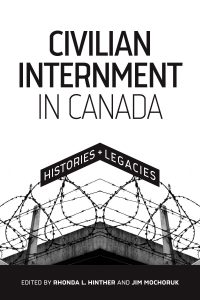Canada, too, confined thousands in internment camps, UND historian’s book recounts
History Professor Jim Mochoruk’s new book explores significance of internment in Canada’s recent past

University of North Dakota history professor Jim Mochoruk calls it negative heritage; the events, policies and actions that receive only cursory mentions in school history books, when they make it onto the pages at all.
Internment, or the forceful confinement of civilians for political reasons, is exactly that sort of negative heritage, most often associated with the Jewish experience in Nazi Germany and the Japanese American incarceration in the U.S., both during World War II. Less known is the history of internment in Canada, a nation heralded today for its tolerant, multicultural society.
That past and its ramifications are the subject of Mochoruk’s latest book, “Civilian Internment in Canada.” He co-authored it with Rhonda l. Hinther, a history professor at Brandon University in Brandon, Man.
A collection of scholarly and personal essays, the book, which came out in February, explores the uncomfortable truths about subjecting ethnic and political communities – including Ukrainian Canadians during and after World War I and Japanese Canadians during and after World War II – to conditions such as undue imprisonment and compulsory labor. It also tackles the complexities that define how the past is remembered and talked about by those who lived it.
And, notably, the book serves as a reminder of how fleeting and fragile civil rights and liberties can actually be.
Mochoruk and Hinther began working on the book in 2015, when they organized a conference in Winnipeg that brought together historians, survivors and activists to dissect the many aspects of internment in Canada. Some of the attendants became contributors to the book, released five years later by the University of Manitoba Press and available for purchase on Amazon.
Below is UND Today’s conversation with Mochoruk, which has been edited for length and clarity.
Why did you decide to explore the topic of internment in Canada?

In the Canadian context, one of the mechanisms that was used to intern civilians was the emergency War Measures Act. It was used both during the First and Second world wars. It was used in 1970 during what’s known as the FLQ crisis in Quebec (that aimed to secure sovereignty for the province).
As my co-author and I began thinking about it, we recognized that although the War Measures Act has now been taken off the books, there are still cases of people being interned and deported and, indeed, having their civil liberties and civil rights restricted in Canada. For example, in the wake of 9/11, there was a real fallout in Canada as well and there are a number of very, very important cases that would actually constitute a type of civilian internment.
What struck us was that these episodes of civilian internment from 1914, the beginning of the First World War, right up to yesterday, were all treated as completely and utterly separate incidents. We wanted to bring together a collection of scholars, survivors of internment, children of those who have been interned and activists who were involved in the redress movement. We wanted to have both scholarly papers and the personal memories of internment survivors.
We hope the book is a useful bringing-together of the civilian internment experience in Canada and the very, very closely allied question of the suspension of civil liberties and civil rights in times of crisis and perceived crisis – questions that we think are still very important to this day.
What stories struck a chord with you?
There were a couple of things that were really, really striking. One of the amazing things about bringing people together from these different internment episodes was that we had people saying, “That’s exactly the way it was for us.” Members of the Japanese community were saying that to people from the Ukrainian community. People didn’t know that this has happened to other people. That was really striking.
But something else that really struck both my co-author and me was the different recollections survivors had, depending on how young they were when they were interned or when they were impacted by this. There is a brilliant young woman who did a paper on German merchant seamen who ended up being interned in Canada during the Second World War. She did extensive oral-history interviews with them. She discovered that the young men, who were 18-22 years old at time, actually saw that internment experience as positive in the course of their life narrative; and many of these folks have gone on to become pretty successful.
They saw the internment experience as, first, having saved them from dying during the war, and second, having exposed them to a very different culture and different possibilities. They all talked about the outdoor life that they lived in these internment camps in very positive terms.
There are also a number of Japanese Canadians who were children at the time of internment. They spoke about their experience in the work camps and in the sugar beet fields where they worked. They spoke about the fun they had as children. They also understood that there was a huge, huge toll paid by their parents; but, as children, they’d had different memories.
For other groups of people, the interment experience was nothing short of complete and utter bitterness and an awful, awful memory. It really shaped them in so many ways.
So you have a whole range of responses. That tells us something about the process of memory.
Talking about memory, what was your approach weaving personal narratives and historical facts that may differ from each other?
 It’s something that we commented upon in our introduction. We are aware that human memory is fallible. Many of us who took part in this project have experience as oral historians and we know that human memory is malleable. It’s not perfect. But, in so many ways, what people remember and how they remember it, especially when we can compare it to some documentary records, tell us so much about the process of how we remember things and how we commemorate things.
It’s something that we commented upon in our introduction. We are aware that human memory is fallible. Many of us who took part in this project have experience as oral historians and we know that human memory is malleable. It’s not perfect. But, in so many ways, what people remember and how they remember it, especially when we can compare it to some documentary records, tell us so much about the process of how we remember things and how we commemorate things.
Another important part of the manuscript is that we can point out that as important as it is that we retain these memories through oral history, we need to balance them with as many other sources as possible. Those individual memories are important and they can tell us things that other sources never will be able to but we also always have to balance these things out. It’s part of the historian’s craft.
The book also deals with the intergenerational trauma of internment. How has this trauma shown up through the decades?
The children of those who have been interned had some remarkable experiences themselves. Even though it wasn’t they themselves who had been interned, the long-term impact on their families was really quite traumatic. One of the things that became very clear was a number of the survivors of the internment experience refused to talk about it with their children. And in some cases, they only ever started talking about it as they became quite old. It was something that they were embarrassed about as if they had done something wrong. Of course, they hadn’t. I think there was a type of bitterness.
During the First World War, a lot of the Eastern Europeans who were interned lost whatever little they had leading into this; the same with the Japanese Canadians during the Second World War. And that was something that no one wanted to have to remember. It was something that really haunted them as parents and, perhaps, even as grandparents.
On a broader scale, how is internment being talked about in Canada today?
One of the big reasons for writing this book was to get more information out to the public. It’s called negative heritage. Most nations only want to celebrate all the positive things. We felt it was really important that Canadians are more aware of these different episodes in the past that don’t fit that lovely triumphalist narrative of, “We’re the greatest country. We’re multicultural, and we’re proud of it.”
It’s a reminder that we have to work very hard at remembering things that we’re not necessarily proud of. Not to be negative about them, but rather, so we don’t make those mistakes again.
In fact, for one of the sections of the book, we had a number of museum professionals writing about how some of these episodes are portrayed at museums across Canada, including the Canadian Museum of Human Rights, the Canadian Museum of Civilization, the Manitoba Museum and a very small museum out in New Brunswick that they’ve tried to create literally on the grounds of a former internment camp. All of those papers talk about how difficult it is to present to the public these stories that people in some ways really don’t want to have to remember.
If you think about it, it’s only recently here in the United States and Canada that we’ve had anything in the school system that talks about the treatment of Japanese Americans and Japanese Canadians during the Second World War. What we’re trying to do is to show people that this is a threat that has been pretty consistent in modern Canadian history.
We need to be ever so vigilant that we don’t do these sorts of things again and deprive people of their rights just because of their race, their ethnicity, their religion or their political beliefs.
This leads to the question of what you hope people retain from reading the book.
We want people to understand that although Canada is officially a multicultural society, that didn’t come easily. People had to fight for the right to retain their cultures, their ideas, their beliefs. Internment of some racialized groups and political groups is part of Canada’s path towards this greater emphasis upon multiculturalism.
The leadership of the Japanese Canadian community, in their fight for redress for what had happened in the Second World War, was instrumental in having that War Measures Act done away with forever and a much less draconian set of laws put in place. So many of the leaders of the Japanese Canadian redress movement became massive fighters for Canadian civil liberties. That’s a story that needs to be told again and again.
It is also very important that people need to be aware that civilian internment and the suspension of civil liberties and civil rights and deportations can go on even during peacetime. In a society like Canada, which prides itself on its multiculturalism and its openness to all, we need to always be on guard. We need to be aware that we’ve done these things in the past. We say it was for the common good, but was it really? We need to ask those questions critically.


